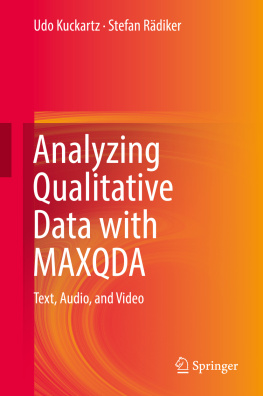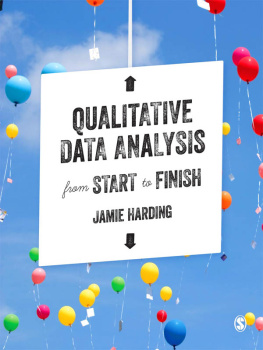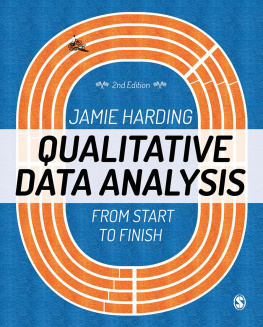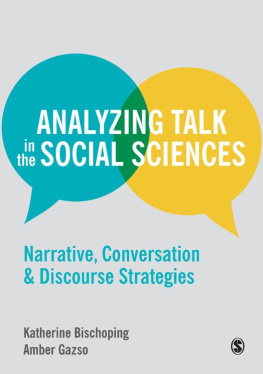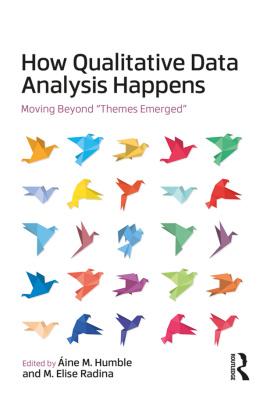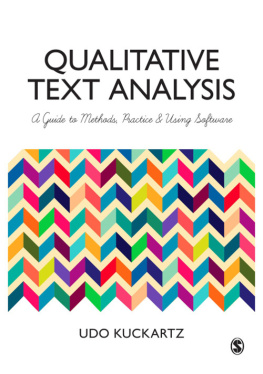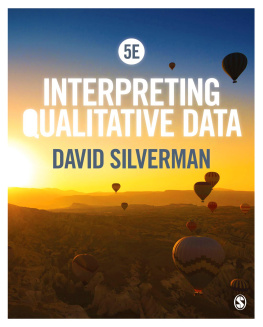Udo Kuckartz - Analyzing Qualitative Data with MAXQDA
Here you can read online Udo Kuckartz - Analyzing Qualitative Data with MAXQDA full text of the book (entire story) in english for free. Download pdf and epub, get meaning, cover and reviews about this ebook. year: 0, publisher: Springer International Publishing, genre: Home and family. Description of the work, (preface) as well as reviews are available. Best literature library LitArk.com created for fans of good reading and offers a wide selection of genres:
Romance novel
Science fiction
Adventure
Detective
Science
History
Home and family
Prose
Art
Politics
Computer
Non-fiction
Religion
Business
Children
Humor
Choose a favorite category and find really read worthwhile books. Enjoy immersion in the world of imagination, feel the emotions of the characters or learn something new for yourself, make an fascinating discovery.
- Book:Analyzing Qualitative Data with MAXQDA
- Author:
- Publisher:Springer International Publishing
- Genre:
- Year:0
- Rating:5 / 5
- Favourites:Add to favourites
- Your mark:
- 100
- 1
- 2
- 3
- 4
- 5
Analyzing Qualitative Data with MAXQDA: summary, description and annotation
We offer to read an annotation, description, summary or preface (depends on what the author of the book "Analyzing Qualitative Data with MAXQDA" wrote himself). If you haven't found the necessary information about the book — write in the comments, we will try to find it.
Analyzing Qualitative Data with MAXQDA — read online for free the complete book (whole text) full work
Below is the text of the book, divided by pages. System saving the place of the last page read, allows you to conveniently read the book "Analyzing Qualitative Data with MAXQDA" online for free, without having to search again every time where you left off. Put a bookmark, and you can go to the page where you finished reading at any time.
Font size:
Interval:
Bookmark:
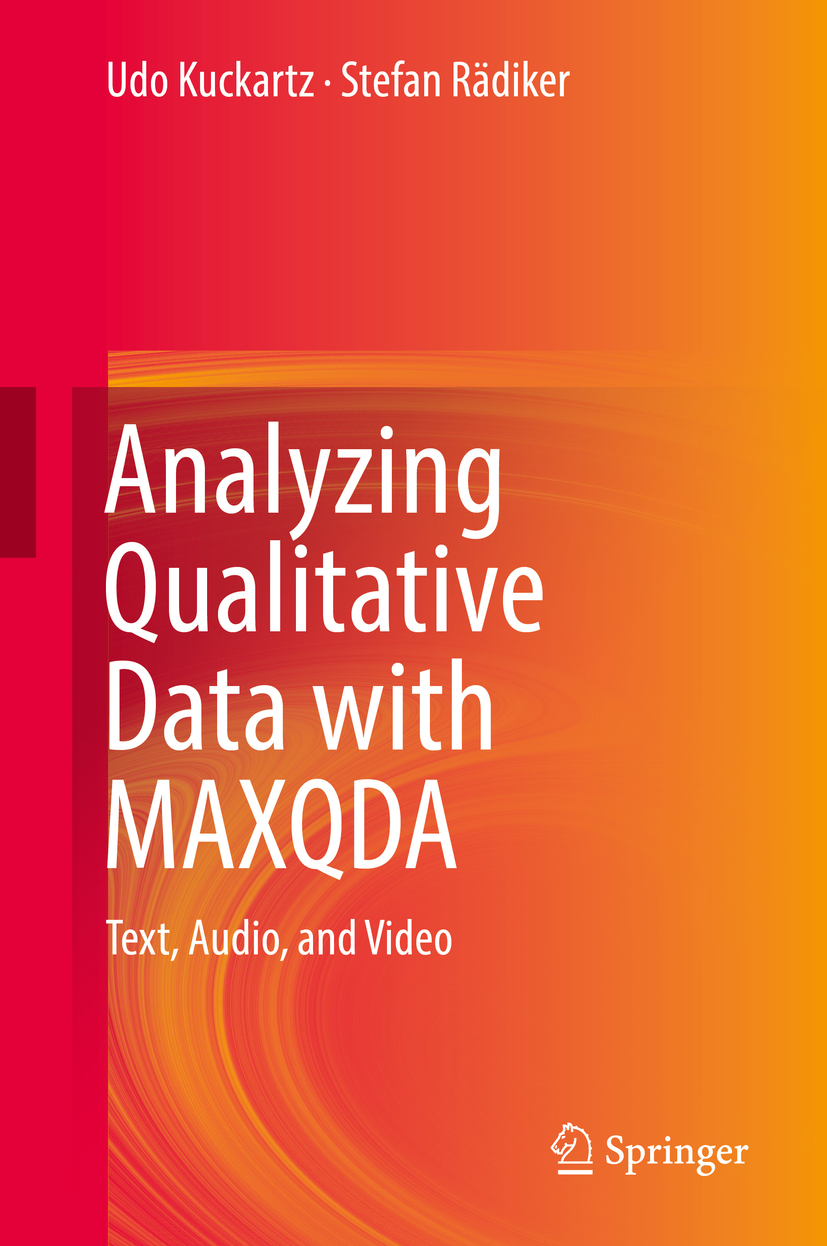

Translation from the German language edition:
Analyse qualitativer Daten mit MAXQDA by Stefan Rdiker, Udo Kuckartz
Copyright Springer Fachmedien Wiesbaden GmbH, part of Springer Nature 2019. All Rights Reserved.
This Springer imprint is published by the registered company Springer Nature Switzerland AG.
The registered company address is: Gewerbestrasse 11, 6330 Cham, Switzerland
To begin at the beginning is the opening line of the play Under Milk Wood by Welsh poet Dylan Thomas. So, we also want to start here at the beginning and start with some information about the history of the analysis software MAXQDA. This story is quite long; it begins in 1989 with a first version of the software, then just called MAX, for the operating system DOS and a book in the German language. The books title was Text Analysis Software for the Social Sciences. Introduction to MAX and Textbase Alpha written by Udo Kuckartz, published by Gustav Fischer in 1992. Since then, there have been many changes and innovations: technological, conceptual, and methodological. MAXQDA has its roots in social science methodology; the original name MAX was reference to the sociologist Max Weber, whose methodology combined quantitative and qualitative methods, explanation, and understanding in a way that was unique at the time, the beginning of the twentieth century. Since the first versions, MAX (later named winMAX and MAXQDA) has always been a very innovative analysis software. In 1994, it was one of the first programs with a graphical user interface; since 2001, it has used Rich Text Format with embedded graphics and objects. Later, MAXQDA was the first QDA program (QDA stands for qualitative data analysis) with a special version for Mac computers that included all analytical functions. Since autumn 2015, MAXQDA has been available in almost identical versions for Windows and Mac, so that users can switch between operating systems without having to familiarize themselves with a new interface or changed functionality. This compatibility and feature equality between Mac and Windows versions is unique and greatly facilitates team collaboration. MAXQDA has also come up with numerous innovations in the intervening years: a logically and very intuitively designed user interface, very versatile options for memos and comments, numerous visualization options, the summary grid as a middle level of analysis between primary data and categories, and much more, for instance, transcription, geolinks, weight scores for coding, analysis of PDF files, and Twitter analysis. Last but not least, the mixed methods features are worth mentioning, in which MAXQDA has long played a pioneering role.
This list already shows that today MAXQDA is much more than text analysis software: the first chapter of this book contains a representation of the data types that MAXQDA can analyze today (in version 2018) and shows which file formats can be processed. The large variety of data types is contrasted by an even greater number of analysis methods. The variety of possibilities is fascinating on the one hand, but also poses us, as authors of this book, the question of what content we should select, which methods and procedures we should describe, and with what degree of detail? It makes a huge difference whether videos from school lessons are analyzed in the context of didactical classroom research, whether narrative interviews are analyzed in biographical research, or whether mixed methods evaluations of development policy measures are carried out. In all the three cases, a specific method is required, each of which would deserve its own treatise, its own step-by-step guideand, of course, there are many other fields of application in addition to these, such as nursing research, environmental research, and technology research. We have tried to deal with as many topics as possible; above all, we focus on those aspects that have a multi-use character and play the same role in many fields of application, in many types of data and methods. This includes, first and foremost, questions relating to the formation of categories, to which we pay particular attention.
In the first main part , the basic functions of MAXQDA are presented after a methodical introduction. The structure follows the logic of the research process. The first chapter Analyzing qualitative data with software contains a short methodological introduction and gives an overview of the analysis options. The following chapters deal with the management of the interface of MAXQDA (Chap. ).
Reading, reflecting, and exploring are the beginning of intensive work with the data (Chap. concludes the basic part of the book. Up to this point, the chapters should be read sequentially, as they are largely based on each other. This recommendation applies in particular to readers who do not yet have any knowledge of computer-assisted analysis of qualitative data.
The second main part of the book is problem oriented (Chaps. focuses on a very popular form of mixed methods research, namely the analysis of (online) survey data with closed and open questions.
The third main part of the book, covering the last four chapters, is again devoted to general topics that are independent of specific types of analysis: Chapter is devoted to questions of documentation and archiving that arise at the very end of a project such as how the analytical work, for example, the coding frame, can be documented.
This book is consciously written with the goal of optimal handling of MAXQDA. Although reference is made to methodological literature, anyone who wants to learn how a qualitative content analysis works, for example, or which methods of video analysis exist, should fall back on the multifaceted methodological literature. In this book, we convey the knowledge necessary to implement existing methods with MAXQDA as comprehensibly and clearly as possible.
Font size:
Interval:
Bookmark:
Similar books «Analyzing Qualitative Data with MAXQDA»
Look at similar books to Analyzing Qualitative Data with MAXQDA. We have selected literature similar in name and meaning in the hope of providing readers with more options to find new, interesting, not yet read works.
Discussion, reviews of the book Analyzing Qualitative Data with MAXQDA and just readers' own opinions. Leave your comments, write what you think about the work, its meaning or the main characters. Specify what exactly you liked and what you didn't like, and why you think so.

